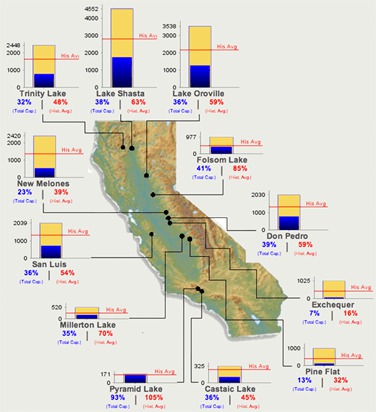California’s Daily Reservoir Levels, per Department of Water Resources’ CDEC [advanced_iframe securitykey=”a60953ca2f356ec54475f2533d06b99879abe615″ src=”https://cdec.water.ca.gov/resapp/RescondMain.do#page_container” width=”90%” height=”945px”]
CDEC Reservoir Levels Map
California relies on water stored during wet years for use during dry years. Water storage, both above and below ground is critical to California. The map below shows how much water is in California’s major above-ground storage. These California’s Daily Reservoir Levels, per Department of Water Resources’ CDEC, is the water currently stored in […]
Reservoir Levels Map
SWP-Recreation
Recreation SWP lakes offer a variety of recreational activities. At Project lakes and reservoirs visitors will find opportunities to swim, picnic, waterski, boat, fish, hike, bike, camp, and horseback ride. Plans to construct the SWP included these recreational facilities for the benefit of the public. Source: California Department of Water Resources
SWP- Fish and Wildlife Protection
Fish and Wildlife Protection The Project is operated to protect the environment. Restricted pumping schedules, fish hatcheries, fish screens and passages, mitigation agreements, fish surveys and monitoring, a fish salvage facility, and habitat restoration, are some of the mechanisms for fish and wildlife protection. The projects are also operated to meet instream flow requirements in […]
SWP-Flood Protection
Flood Control One of the SWP’s primary functions is flood control in Northern California. A major flood in 1955 was the impetus for the construction of Lake Oroville. Storage space is provided in Oroville and Lake Del Valle to capture flood flows and protect areas downstream. Releases are coordinated with other flood control reservoirs so […]
SWP- Power
Power The State Water Project requires dependable, economical power to pump water to areas served by the Project’s contractors. Since 1984 SWP power requirements have ranged from more than 8 billion kilowatthours a year, as in 1990, to under 4 billion kwh, as in 1995. Today the SWP is one of California’s larger energy producers […]
State Water Project
CALIFORNIA STATE WATER PROJECT The State Water Project has helped fuel the economic growth of California. But that economic growth will suffer as jobs are lost and expenses increase due to the lack of a reliable water supply. The SWP’s main purposes are to provide water storage and delivery. Its supply comes mainly from rainfall, […]
